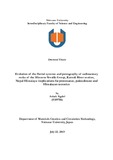Please use this identifier to cite or link to this item:
http://archive.nnl.gov.np:8080/handle/123456789/434| Title: | Evolution of the fluvial systems and petrography of sedimentary rocks of the Miocene Siwalik Group, Karnali River section, Nepal Himalaya: implications for provenance, paleoclimate and Himalayan tectonics |
| Authors: | Sigdel, Ashok |
| Keywords: | Geology -- Nepal Himalaya Siwalik Group Karnali River Lithostratigraphy |
| Issue Date: | 25-Feb-2018 |
| Abstract: | Fluvial deposit of the Miocene Siwalik Group (4000–6500 m thick) was accumulated in the Himalaya foreland basin. The Siwalik Group is considered to be an important archive of Himalayan uplift and related climate changes. It is thought that uplift of the Himalaya affected world climate pattern. A noticeable effect was global cooling due to the absorption of carbon dioxide by the chemical weathering process induced by increased rainfall (Indian Summer Monsoon) due to uplift. Although several studies have been focused on the Siwalik Group by using different methods to reconstruct the monsoonal climate change, the lack of the studies on possible causes of the gap of the estimated timing of climate change is not yet clear. One probable cause is the effect of local climate change induced by local topography. This study analyzes the fluvial successions of the Siwalik Group along the Karnali River, where the large paleo-Karnali River is presumed to have flowed, and in which local climatic effects should be minimal. Therefore, the Karnali River section is expected to contain a good record of regional changes in climate and tectonics. Because fluvial facies are directly affected by increased precipitation related to climate change and increase in sediment supply associated with uplift, lithostratigraphic and fluvial facies studies were conducted to understand the changes in depositional system. Petrographic analysis was also carried out to determine the sediment source area and related tectonic setting. The newly established stratigraphy of the Karnali River section is: Chisapani Formation (equivalent to Lower Siwalik, (2045 m), Baka Formation (equivalent to Middle Siwalik, (2740 m), Kuine and Panikhola Gaun Formations (equivalent to Upper Siwalik, 1500 m) in ascending order. The Chisapani Formation is composed of interbedded red mudstones and fine- to medium-grained sandstones. The Baka Formation is composed of medium- to coarse-grained ‘salt and pepper’, pebbly sandstones interbedded with greenish grey mudstones. The Kuine and Panikhola Gaun Formations consist of thick pebble, cobble to boulder conglomerates. Based on facies analysis, six facies associations (FA1-FA6) were identified. The individual facies associations represent fine-grained meandering river systems (FA1), flood flow-dominated meandering river system (FA2), deep (FA3) and shallow (FA4) sandy braided river systems, followed by gravelly braided river systems (FA5) and a debris flow-dominated braided river system (FA6), respectively. The facies change from FA1 to FA2 is an important indicator of climate change. The change from fine-grained meandering river deposits with red soils (15.8-13.5 Ma) to the flood flow-dominated meandering river deposits with greenish grey mudstones (13.5-9.6 Ma) indicates increased water discharge after 13.5 Ma, which resulted from increased precipitation. Appearance of playa lake facies in FA2 also reflects a seasonal increase in precipitation. In contrast, the timing of this facies change ranges from 10.5 to 9.5 Ma in other Nepal Siwalik sections. The earlier facies changes in the Karnali River section at about 13.5 Ma may have been due to intensification of the Indian Summer Monsoon. Earlier uplift in the western Nepal Himalaya may also have caused higher orographic rainfall in this region. The change from a meandering river system to a braided river system at about 9.6 Ma is probably related to progradation of large alluvial fans in the ancient Indo-Gangatic Plain. The results of petrographic analysis confirm that the sediments were mainly derived from the Higher Himalaya and the Lesser Himalaya throughout the deposition. The Higher Himalaya was a major source terrain even in the early stage (16.0 Ma) of deposition, and Lesser Himalayan contribution increased after 13.0 Ma. This indicates the Lesser and the Higher Himalayas were deeply incised by the large paleo-Karnali River. The petrographic results along with previous studies from all Siwalik sections suggest the diachronous uplift of the Himalaya, which began earlier in far western Nepal. The early uplift and related orographic rainfall are consistent with other studies which show extension of drier areas in western China and restriction of humid areas to southern China during the late middle Miocene (13.5 Ma). The uplift may have suppressed deep penetration of wind originating from the Indian Ocean to the Tibetan Plateau, creating a rain shadow zone in western China, and significant orographic rainfall in the frontal Himalaya. |
| Description: | Doctoral Thesis, Interdisciplinary Faculty of Science and Engineering, Department of Materials Creation and Circulation Technology, Shimane University, Japan, 2013. |
| URI: | http://103.69.125.248:8080/xmlui/handle/123456789/434 |
| Appears in Collections: | 600 Technology (Applied sciences) |
Files in This Item:
| File | Description | Size | Format | |
|---|---|---|---|---|
| final thesis.pdf | 36.82 MB | Adobe PDF |  View/Open |
Items in DSpace are protected by copyright, with all rights reserved, unless otherwise indicated.